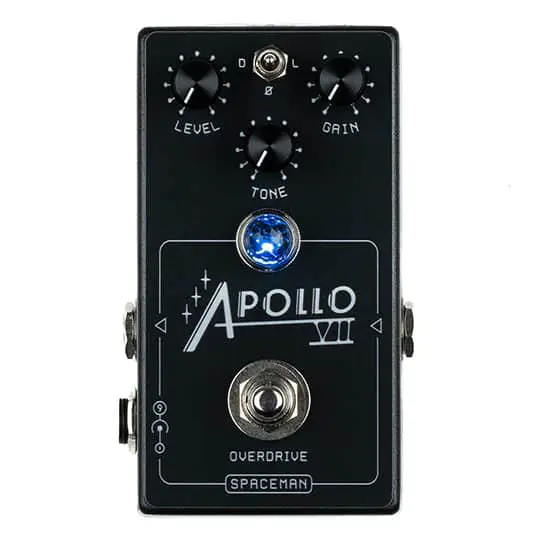
It is reported that tribes living in the jungle have hundreds of words for the color green – because there are so many shades of green, in the jungle.
Similarly, electric guitarists gifted with a supernatural ear can discern the tone of hundreds of different overdrive pedals, because there are so many overdrive pedals, out there. With the aggravating circumstance that this list is constantly (and rather rapidly) growing… Thing is, overdrives are the best-selling pedal effects, so all manufacturers want to have a shot at it.
This being said, Portland’s Spaceman Effects has demonstrated to be a great player in this competitive field.
The Spaceman Apollo VII is was born from the Voyager I, the Portland builder’s popular optical tremolo.
The three controls (Level, Gain and Tone) were optimized to offer a wide variety of tones, with up to 40dBs of gain on tap, while the toggle switch provides access to three clipping diode modes:
LED clipping offers mid-range focused grit – this is the sound of the Voyager I.
Silicon diode clipping provides a more compressed and aggressive sound with a smoother decay tail.
With no clipping diodes in circuit, the Apollo VII becomes much more touch-sensitive and will growl and bark with astounding dynamic variation.
Several videos of this pedal came out, here’s a selection for you.
Inspired by the incredible response to the Voyager I tremolo, we’ve carefully extracted the drive and tone-shaping elements to create the Apollo VII. Familiar sounds and new features collide in this explosive new design.
The simple control interface houses new and refined features while offering the highly regarded tone of the original. As a tribute to the Apollo VII, NASA’s first three-person space mission, there are three controls: level, gain and tone. Each has been optimized to offer a wide variety of sounds, with up to 40dB of gain on tap. The toggle switch also provides three options: LED clipping, silicon diode clipping, and no diodes. LED clipping offers mid-range focused grit – this is the sound of the Voyager I. Silicon diode clipping provides a more compressed and aggressive sound with a smoother decay tail. With no clipping diodes in circuit, the Apollo VII becomes much more touch-sensitive and will growl and bark with astounding dynamic variation.






















